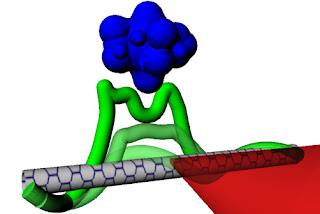To create the sensors, chemical engineers led by Michael Strano coated carbon nanotubes â€" hollow, one-atom-thick cylinders made of pure carbon â€" with protein fragments normally found in bee venom. This is the first time those proteins have been shown to react to explosives, specifically a class known as nitro-aromatic compounds that includes TNT.
If developed into commercial devices, such sensors would be far more sensitive than existing explosives detectors â€" commonly used at airports, for example â€" which use spectrometry to analyze charged particles as they move through the air.
“Ion mobility spectrometers are widely deployed because they are inexpensive and very reliable. However, this next generation of nanosensors can improve upon this by having the ultimate detection limit, [detecting] single molecules of explosives at room temperature and atmospheric pressure,†says Strano, the Charles (1951) and Hilda Roddey Career Development Associate Professor of Chemical Engineering.

The system in action. Image: Ardemis Boghossian and Daniel HelleA former graduate student in Strano’s lab, Daniel Heller (now a Damon Runyon Fellow at MIT’s David H. Koch Institute for Integrative Cancer Research), is lead author of a paper describing the technology in the Proceedings of the National Academy of Sciences. The paper appears online this week.
Strano has filed for a patent on the technology, which makes use of protein fragments called bombolitins. “Scientists have studied these peptides, but as far as we know, they’ve never been shown to have an affinity for and recognize explosive molecules in any way,†he says.
In recent years, Strano’s lab has developed carbon-nanotube sensors for a variety of molecules, including nitric oxide, hydrogen peroxide and toxic agents such as the nerve gas sarin. Such sensors take advantage of carbon nanotubes’ natural fluorescence, by coupling them to a molecule that binds to a specific target. When the target is bound, the tubes’ fluorescence brightens or dims.
The new explosives sensor works in a slightly different way. When the target binds to the bee-venom proteins coating the nanotubes, it shifts the fluorescent light’s wavelength, instead of changing its intensity. The researchers built a new type of microscope to read the signal, which can’t be seen with the naked eye. This type of sensor, the first of its kind, is easier to work with because it is not influenced by ambient light.
“For a fluorescent sensor, using the intensity of the fluorescent light to read the signal is more error-prone and noisier than measuring a wavelength,†Strano says.
Each nanotube-peptide combination reacts differently to different nitro-aromatic compounds. By using several different nanotubes coated in different bombolitins, the researchers can identify a unique “fingerprint†for each explosive they might want to detect. The nanotubes can also sense the breakdown products of such explosives.
“Compounds such as TNT decompose in the environment, creating other molecule types, and those derivatives could also be identified with this type of sensor,†Strano says. “Because molecules in the environment are constantly changing into other chemicals, we need sensor platforms that can detect the entire network and classes of chemicals, instead of just one type.â€
The researchers also showed that the nanotubes can detect two pesticides that are nitro-aromatic compounds as well, making them potentially useful as environmental sensors. The research was funded by the Institute for Soldier Nanotechnologies at MIT.
Philip Collins, a professor of physics at the University of California at Irvine, says the new approach is a novel extension of Strano’s previous work on carbon-nanotube sensors. “It’s nice what they’ve done â€" combined a couple of different things that are not sensitive to explosives, and shown that the combination is sensitive,†says Collins, who was not involved in this research.
The technology has already drawn commercial and military interest, Strano says. For the sensor to become practical for widespread use, it would have to be coupled with a commercially available concentrator that would bring any molecules floating in the air in contact with the carbon nanotubes.
“It doesn’t mean that we are ready to put these onto a subway and detect explosives immediately. But it does mean that now the sensor itself is no longer the bottleneck,†Strano says. “If there’s one molecule in a sample, and if you can get it to the sensor, you can now detect and quantify it.â€
Other researchers from MIT involved in the work include former postdocs Nitish Nair and Paul Barone; graduate students Jingqing Zhang, Ardemis Boghossian and Nigel Reuel; George Pratt ’10 and junior Adam Hansborough.
Written by: Anne Trafton, MIT News Office.
Contact: Caroline McCall cmccall5@mit.edu WEB:Massachusetts Institute of Technology
